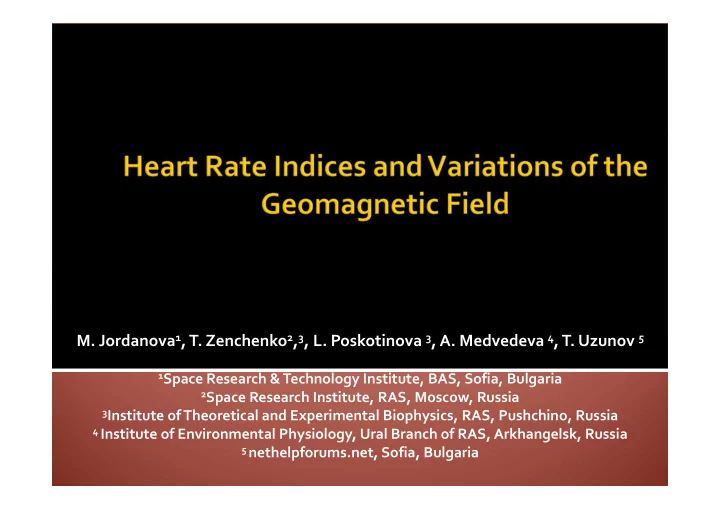

M. Jordanova 1 , T. Zenchenko 2 , 3 , L. Poskotinova 3 , A. Medvedeva 4 , T. Uzunov 5 1 Space Research & Technology Institute, BAS, Sofia, Bulgaria 2 Space Research Institute, RAS, Moscow, Russia 3 Institute of Theoretical and Experimental Biophysics, RAS, Pushchino, Russia 4 Institute of Environmental Physiology, Ural Branch of RAS, Arkhangelsk, Russia 5 nethelpforums.net, Sofia, Bulgaria
Fifth Workshop "Solar Influences on the Magnetosphere, Ionosphere and 3-7.6.2013 Atmosphere, Nessebar, Bulgaria 2
Heliobiology Duration: 2011 ‐ 2015 Partners Goals: To study the relationship between geomagnetic activity, meteorology factors and human behavior Fifth Workshop "Solar Influences on the Magnetosphere, Ionosphere and 3-7.6.2013 Atmosphere, Nessebar, Bulgaria 3
Studying the effects of GMA on behavior of healthy, middle age volunteers; Studying the effects of preliminary advertisement of possible magnetic storms on the wellbeing of health volunteers (well ‐ being surveys); Studying the link between geomagnetic activity and the occurrence of cerebral pathology; Studying the lag between the time of manifestation of cerebrovascular accidents, if any, and the geomagnetic indexes; Studying the relation between the cerebral vascular pathology (ischemic or hemorrhagic cerebral infarction) and the stages of magnetic storms, i.e. to confirm or reject the theory that during geomagnetic disturbances the microcirculation parameters of human brain may undergo rapid changes from increased coagulation (i.e. increased probability of thrombosis) to decreased viscosity (i.e. increased probability of hemorrhages) Fifth Workshop "Solar Influences on the Magnetosphere, Ionosphere and 3-7.6.2013 Atmosphere, Nessebar, Bulgaria 4
The potential effect that the geomagnetic activity may have on human physiological parameters (such as heart rate, arterial diastolic and systolic pressure) is widely investigated There are evidence that human health can be affected by solar activity and related geophysical changes (GMS) Yet, the parameters affected and the mechanisms are not clear Fifth Workshop "Solar Influences on the Magnetosphere, Ionosphere and 3-7.6.2013 Atmosphere, Nessebar, Bulgaria 5
Magnetic field changes interfere with the action of pineal cells in synthesizing melatonin Melatonin hypotheses ‐ temporal variation in the geomagnetic field may be acting as an additional zeitgeber (a temporal synchronizer) for circadian rhythms Cryptochrome gene theory ‐ cryptochrome compass system is mediating stress responses more broadly across the hypothalamic–pituitary–adrenal axis (including alterations to circadian behavior) in response to changes in the geomagnetic field NB Cryptochrome gene is one of the 8 clock genes … Lack of sufficient amount of experimental data with humans Fifth Workshop "Solar Influences on the Magnetosphere, Ionosphere and 3-7.6.2013 Atmosphere, Nessebar, Bulgaria 6
To study the degree of conjugation of the heart rate variability (and autonomic nervous system) with variations of the geomagnetic field in the frequency range from 0.5 to 3 MHz (5 ‐ 30 min) and its dependence on the latitude of the place of observation Fifth Workshop "Solar Influences on the Magnetosphere, Ionosphere and 3-7.6.2013 Atmosphere, Nessebar, Bulgaria 7
(Difficult & Time Consuming) Fifth Workshop "Solar Influences on the Magnetosphere, Ionosphere and 3-7.6.2013 Atmosphere, Nessebar, Bulgaria 8
Healthy volunteers Sofia, Bulgaria 42° 40' N 23° 20' E 1. Moscow, Russia 55° 45' N 37 ° 36‘ E 2. Arkhangelsk, Russia 64° 34' N / 40° 32' E 3. Heart activity (ECG, heart rates, etc.) Measurements ‐ 60 ‐ 100 minutes, 10 minutes of adaptation, at rest but not sleeping, dietary requiments … Device ‐ Kardi ‐ 2, four leads Data – INTERMAGNET (International Real ‐ time Magnetic Observatory Network, ottawa.intermagnet.org/Welcom_e.php Fifth Workshop "Solar Influences on the Magnetosphere, Ionosphere and 3-7.6.2013 Atmosphere, Nessebar, Bulgaria 9
Fifth Workshop "Solar Influences on the Magnetosphere, Ionosphere and 3-7.6.2013 Atmosphere, Nessebar, Bulgaria 10
Fifth Workshop "Solar Influences on the Magnetosphere, Ionosphere and 3-7.6.2013 Atmosphere, Nessebar, Bulgaria 11
filter Blackman & Harris Fifth Workshop "Solar Influences on the Magnetosphere, Ionosphere and 3-7.6.2013 Atmosphere, Nessebar, Bulgaria 12
Fifth Workshop "Solar Influences on the Magnetosphere, Ionosphere and 3-7.6.2013 Atmosphere, Nessebar, Bulgaria 13
Fifth Workshop "Solar Influences on the Magnetosphere, Ionosphere and 3-7.6.2013 Atmosphere, Nessebar, Bulgaria 14
Fifth Workshop "Solar Influences on the Magnetosphere, Ionosphere and 3-7.6.2013 Atmosphere, Nessebar, Bulgaria 15
The effect of synchronization heart rate parameters of healthy subjects and variations of the magnetic field vectors oscillation was observed The effect is reproduced ~ 60% in successive experiments The effect does not depend on gender and age of the subject or of the place of the experiment The effect better visible in periods without GMS The heart rate reveals the highest sensitivity to X axis All pieces of info count! Further experiments are a must in order to answer the questions: at which level is an influence of GMF variations on cardiovascular parameters ‐ directly on cardiomyocytes (modulating the process of passing the excitation) or at the level of ANS, through an indirect impact on the parameters of heart rate Are there an individual differences in the reaction? … Fifth Workshop "Solar Influences on the Magnetosphere, Ionosphere and 3-7.6.2013 Atmosphere, Nessebar, Bulgaria 16
Magnetic sensitivity is phylogenetically widespread It exists in all major groups of vertebrate animals (chickens and mole rats, etc.), as well as in some mollusks, crustaceans and insects. Biological responses can vary with the same input data. It is the biological reaction that matters Earth Present forms day Magnetotactic (4.5 bn) bacteria Bird compass Electrification Early man (2 bn) (90 m) (130 yrs ago) (6 m) Big Bang (13.2 bn) 10 11 10 10 10 9 10 8 10 7 10 6 10 5 10 4 10 3 10 2 10 1 1 Time (years) Source: Henshaw D. 2011, The interaction of magnetic …, http://www.electric ‐ fields.bris.ac.uk/ Fifth Workshop "Solar Influences on the Magnetosphere, Ionosphere and 3-7.6.2013 Atmosphere, Nessebar, Bulgaria 17
Fifth Workshop "Solar Influences on the Magnetosphere, Ionosphere and 3-7.6.2013 Atmosphere, Nessebar, Bulgaria 18
Recommend
More recommend